You use your kitchen sink several times, every day. You tend to put a lot of things intentionally and accidentally into the sink which includes food waste, hair, soap and others. Sometimes, these objects get drained and reach the sewers. In most cases, the soap and grease would attract all the objects to attach to it. This will cause an effect very similar to that of a rolling rock on a snow mountain. This avalanche effect would lead to a larger gunk inside the pipe. The gunk would stop the water from flowing effectively or completely block the draining of the sink. This is called as clog. The most commonly clogged drain inside a house would be the kitchen sink drain.
Unclog A Kitchen Sink Drain
This article has a list of working methods which ranges from very simple home based remedy to professional machines which would help you solve this problem.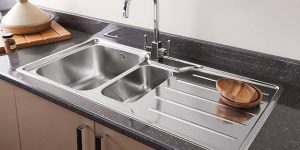 Not all methods would work for everyone. It depends on the location of the clog, type of clog and many other factors. In the same tone, a method which worked for you in the past has no guarantee to work for you in the future. You are welcome to use trial and error method to find the method that works for you.
Not all methods would work for everyone. It depends on the location of the clog, type of clog and many other factors. In the same tone, a method which worked for you in the past has no guarantee to work for you in the future. You are welcome to use trial and error method to find the method that works for you.
Before you get into any method, add a pot of hot boiling water into the drain directly after removing any standing water. In case of small clogs or mild blockage, it would be very helpful. It is also a good preventive measure to avoid clog formation in your drain.
Top 10 Ways to Unclog Kitchen Sink Drain:
- Plunger
- Vinegar soda method
- Auger
- Check your garbage disposal
- Chemical drain cleaners
- Bio drain cleaners
- Salt and water
- Liquid dish detergent
- Wet / dry vacuum
- Suction machine
1. Plunger to Unclog Kitchen Sink Drain
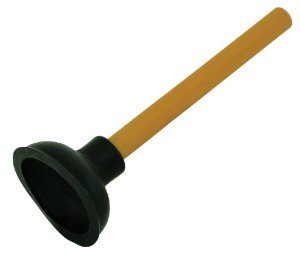 Fill the sink with hot water. Boiling water would do good. If you have two sinks, stuff a cloth into the sink hole that is not clogged. This will give you the pressure needed. Place the plunger on the clogged sink hole and work it up and down, a couple of times. Check whether the water is getting drained faster. If so, you have cleared the clog. In some cases, the water inside the drain will raise up and then get drained completely. If you find any clog raising up, do not flush it back into the drain again. Remove it and dispose it in along with your garbage.
Fill the sink with hot water. Boiling water would do good. If you have two sinks, stuff a cloth into the sink hole that is not clogged. This will give you the pressure needed. Place the plunger on the clogged sink hole and work it up and down, a couple of times. Check whether the water is getting drained faster. If so, you have cleared the clog. In some cases, the water inside the drain will raise up and then get drained completely. If you find any clog raising up, do not flush it back into the drain again. Remove it and dispose it in along with your garbage.
There are handheld and power plungers available on the market. While using power plunger, remember that high pressure would cause damage to the pipelines and it would reduce the pressure which is needed for the water to drain.
2. Use Vinegar and Soda Method to Unclog Kitchen Sink Drain
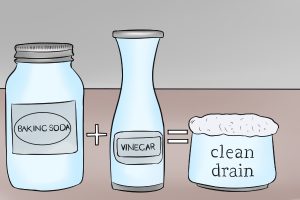 Vinegar and baking soda is very common method of unclogging a kitchen sink drain for those who do not want to do anything mechanical. For this method, there should be no water standing, inside the sink. Use a bucket and mug or any other method to remove all standing water. Add a cup of baking soda into the drain. Add a cup of any brand and any type of vinegar into the drain in such a way that the baking soda gets drenched with vinegar and starts bubbling. Allow a little time for the solution to react with the clog. Now add a liter of boiling water straight into the drain. This will clear out the clog. Repeat the process, if needed, as many times as required.
Vinegar and baking soda is very common method of unclogging a kitchen sink drain for those who do not want to do anything mechanical. For this method, there should be no water standing, inside the sink. Use a bucket and mug or any other method to remove all standing water. Add a cup of baking soda into the drain. Add a cup of any brand and any type of vinegar into the drain in such a way that the baking soda gets drenched with vinegar and starts bubbling. Allow a little time for the solution to react with the clog. Now add a liter of boiling water straight into the drain. This will clear out the clog. Repeat the process, if needed, as many times as required.
This method does not cause any damage to the pipes and can be used as a preventive measure too. You can use this method along with any other method mentioned in this article except the chemical drain cleaner method which will be explained later in the article.
Some add a little lemon juice along with this solution to reduce the odor created during this reaction. Do not prepare this solution beforehand. The reaction has to happen during the unclogging process.
3. Drain Auger to Unclog Kitchen Sink Drain
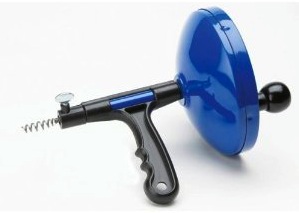 Open the cabinet below your sink. You will find a u-shaped tube that connects to the wall and the bottom of the sink. Try to unscrew the pipes using the hexagonal rim found on the pipes. If not possible, use a wrench on those hexagonal fittings. Do not violently pull it out. You might damage the threading and it would be difficult to fit it again. There will be dirty water and clog inside that u-shaped fitting. So, place a bucket underneath it and also have a few cleaning cloths handy. Wear safety gloves remove the u-tube and empty the clog and water in the u-tube. Use a small brush or old toothbrush to push the clog in the tube into the bucket. Remove the pipe that is attached to the wall. You will find the sewer line opening. Insert a plumber’s drain auger and feed it into the hole, till you find resistance. This is where the clog is located. Now, crank the handle in a rotational direction and push the auger deeper into the pipe. This will make the clog to get attached to the auger. Now, as you rotate in the same direction, pull the auger out. Do not pull with force. Reattach the cable and pour a liter of boiling hot water into the drain to push out any clog which did not meet the auger. You can also use vinegar soda solution. The aim of the auger is to pull the clog out of the drain and not push it deep inside. If you push it deep, you may have to call professionals to use high powered machines which would cost more.
Open the cabinet below your sink. You will find a u-shaped tube that connects to the wall and the bottom of the sink. Try to unscrew the pipes using the hexagonal rim found on the pipes. If not possible, use a wrench on those hexagonal fittings. Do not violently pull it out. You might damage the threading and it would be difficult to fit it again. There will be dirty water and clog inside that u-shaped fitting. So, place a bucket underneath it and also have a few cleaning cloths handy. Wear safety gloves remove the u-tube and empty the clog and water in the u-tube. Use a small brush or old toothbrush to push the clog in the tube into the bucket. Remove the pipe that is attached to the wall. You will find the sewer line opening. Insert a plumber’s drain auger and feed it into the hole, till you find resistance. This is where the clog is located. Now, crank the handle in a rotational direction and push the auger deeper into the pipe. This will make the clog to get attached to the auger. Now, as you rotate in the same direction, pull the auger out. Do not pull with force. Reattach the cable and pour a liter of boiling hot water into the drain to push out any clog which did not meet the auger. You can also use vinegar soda solution. The aim of the auger is to pull the clog out of the drain and not push it deep inside. If you push it deep, you may have to call professionals to use high powered machines which would cost more.
There are plumbing augers available for rent. These augers are operated with electricity. The power of this machine is high and forceful nudge to the sides of the pipe would crack it or break it. A cracked or broken pipe will no longer insert pressure and thus, draining speed would be totally affected. Power augers are needed only when the clog is too far away from the sewer opening. In such cases, it is better to leave it to professionals.
This process is very similar to that of a plumber’s snake. You need to remove the clog through the sewer line. In case of a snake, you can directly insert it through the kitchen sink drain hole. It is better to avoid wire hangers as they may get struck in the pipe leading to serious problems and damage to the pipeline.
4. Check Your Garbage Disposal
If you have a garbage disposal near your sink, you should first check whether the garbage disposal is clogged or not. A clogged garbage disposal is one of the main reasons for a clogged sink. How to identify whether it is a clogged kitchen sink drain or a clogged garbage disposal line? Switch to the disposal and listen to the sound. If you hear a low humming sound, it is your garbage disposal is clogged. If so, work on the clog in the garbage disposal, your sink would become unclogged.
In some cases, clogged roof drain would lead to slowed draining of water in other drains inside the house, including kitchen sink drain. If the water drains slowly as it makes a loud noise, it indicates that your roof drain is clogged. You can either hire professionals to unclog the roof drain or use any other method as per your convenience.
5. Chemical Drain Cleaners to Unclog Kitchen Sink Drain
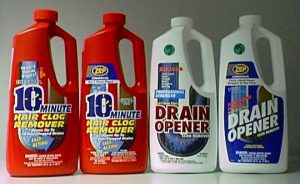 The chemical drain cleaners should be your last resort before you call the professionals. there are numerous types of chemical drain cleaners available in the market. Some of them are marketed as cleaners for clogged kitchen sink drain. You can choose whichever one you want or you can use trial and error method. We are not here to review and compare brands. It is up to you to choose the brand. Almost all chemical drain cleaner brands use the same type of main chemicals. Some may be stronger than the others.
The chemical drain cleaners should be your last resort before you call the professionals. there are numerous types of chemical drain cleaners available in the market. Some of them are marketed as cleaners for clogged kitchen sink drain. You can choose whichever one you want or you can use trial and error method. We are not here to review and compare brands. It is up to you to choose the brand. Almost all chemical drain cleaner brands use the same type of main chemicals. Some may be stronger than the others.
- Also check: Best Liquid Drain Cleaner
Each brand of kitchen sink drain cleaner will have a different set of instructions. Follow the instructions given behind the bottle with caution. Pour the liquid into the drain and wait for it to act. It would take a few minutes to act on the clog. So, use it overnight. In the morning, flush it down with water. Clean the sink completely before using it after applying chemical drain openers. Here are a few tips that you should know, before using these cleaners.
- Keep it away from children and pets.
- Do not mix two different types of chemical cleaners. Do not add more chemical cleaner solution into the sink.
- Do not use vinegar soda solution or any method that involves pressure immediately after using chemical drain cleaners. You can snake the drain after using chemical drain openers.
- Always use cold water or lukewarm water before and after using chemical drain openers.
Let it be the last method that you try. Since, it is dangerous to try any other method after a failed kitchen sink drain unclogging procedure using chemical drain cleaners. It is better to call professionals after this and mention the type of chemical drain cleaner that you used.
6. Bio Drain Cleaners to Unclog Kitchen Sink Drain
Most of the waste that gets clogged inside a kitchen sink drain is organic. In case of bio drain cleaners, bacterial enzymes are introduced into the drain. They feed on organic waste and multiply. With more bacteria, more amount of waste is decomposed. These bacteria will feed on the material in the clog and dissolve it. It would take some time for the bacteria to work on the entire clog. Do not add hot water or any chemical drain cleaner into the drain while the bacteria are under work. Any harsh solution would kill the bacteria or reduce its efficiency. Those who are concerned about the environment and also those who do not want to keep harsh chemicals in their house can use this type of cleaner.
7. Salt and Water to Unclog Kitchen Sink Drain
Remove standing water from the sink and add ½ cup of salt into the drain. Add a liter of boiling water into the drain. Wait for a few minutes for the solution to work on the clog, inside your kitchen sink drain. Now, flush it down with hot water. If the water flow is slow, use a plunger. The salt would have softened the clog and it would be easier for the plunger to work on the clog now. Salt will act as a scouring agent and the hot water will dissolve the grease to an extent. You can use any type of salt like kosher salt, table salt or sea salt.
8. Liquid Dish Detergent to Kitchen Sink Drain
Mostly the clog will be held together by grease or oil that you used for cooking. If the grease is removed, the other particles in the clog will drain along with the flowing water. How should you remove the grease? The liquid dish detergent is a good dissolver of grease. Heat two liters of water in a pot and add a few large tablespoons of dish washing liquid detergent. Now, pour the solution into the drain. Add a liter of hot water into the clogged kitchen sink drain after a few minutes. You can also mix the detergent with normal water and then, add boiling water, after a few minutes.
9. Wet Vacuum to Unclog Kitchen Sink Drain
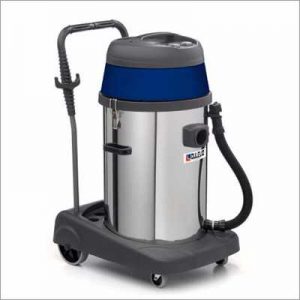 If you have a wet vacuum, you can use it for unclogging very hard clogs in your kitchen sink drain.
If you have a wet vacuum, you can use it for unclogging very hard clogs in your kitchen sink drain.
If you don’t have one it’s a great buy that will provide value for years. Here is a good selection of wet / dry vacuums with good drain cleaning capability. You can also rent a wet vacuum from any hardware rental shop near you.
It is very easy to use a wet vacuum. It is very similar to that of your normal vacuum. For safety, have a cleaning cloth nearby and wear gloves. Here are the steps to use your wet vacuum. Before you set up the machine, remove the pipes in a similar manner as explained in the auger section. You would be inserting the wet vacuum into the hole in the wall.
- Set up the machine by plugging into a socket. Do not switch it on.
- Hook the hose in the machine to the exhaust section. If you switch it on, you would be hearing a loud high pitch sound. This is the sound of the machine running when there is nothing to suck.
- Measure the diameter of your sink hole on the sewer line end. Use a hose to suit the size of your sink hole. Larger hose would lead to damage in the pipeline. Damage in the pipeline would reduce pressure and it has to be replaced. It would be a very costly and time consuming repair. So, choose your hose wisely.
- Feed the hose into the drain till you are resisted by the clog. Now, switch on the machine. You would hear a roaring sound as the motor sucks the clog.
- Once the sucking is completed, you would hear a hollow loud pitched noise. This indicates that the clog is removed.
- Switch off the machine and remove it slowly.
10. Suction Machine to Unclog Kitchen Sink Drain
If the clog is very deep in the pipe, normal wet vacuum cannot be effective to unclog you kitchen sink drain. If you are able to rent a suction machine, you can use it. Do not use it directly on the drain hole. You need to use it after removing the pipes as mentioned in the auger section. Here are the steps to follow while using a suction machine.
- Remove all loose accessories. Remove any small objects around you like keys, bolts and others.
- Learn to use the foot switch. Insert the hose into and out of the drain hole a few times to get the knack of handling the hose.
- Now, switch on the machine and slowly feed the hose into the hole.
- Once you feel the resistance, switch on the machine.
- When you hear a change in the sound of the motor, switch off the machine and remove the hose slowly.
This is a very high powered suction equipment! It is better to let professionals handle this type of machine. If you are planning to do it on your own, make sure to do it slowly without inserting too much pressure. Damaging pipelines would cause serious problems and heavy repair processes.
Help From Professional Drain Cleaners/Plumbers
In certain cases, none of the above stated methods work. It is important to know that clog is not the only reason for a clogged kitchen sink drain. You need to make sure that there are no cracks in the pipeline. This can be done only by professionals. There are a lot of professional service providers around you who would be able to help you with these types of problems. In some cases, the clog will be very deep in the sewer line and it can be only removed using sewer suction machine. This is a dangerous machine and needs extended experience in handling it. Thus, leave it to professional plumbers even if there are options of renting such equipment, near your locality.
Conclusion
It is not possible to avoid draining grease or small sized food wastes through the sink drain. It is better to use vinegar soda solution or salt with boiling water once in a while to keep your drain cleaner. If kitchen sink drain clog occurs in higher frequency, it is better to get your drain pipes completely checked by a professional.